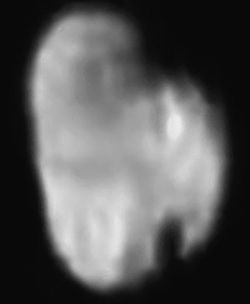Hydra (Moon)
 From Conservapedia
From Conservapedia | Hydra | |
|---|---|
 | |
| Date of discovery | May 15, 2005[1] |
| Name of discoverer | Hubble Space Telescope Pluto Companion Search Team[2] |
| Name origin | Mythical 9-headed monster; second initial of "New Horizons" mission[3][4] |
| Orbital characteristics | |
| Primary | Pluto |
| Order from primary | 3 |
| Perihadion | 64,458 km |
| Aphadion | 65,102 km |
| Semi-major axis | 64,780 km |
| Orbital eccentricity | 0.005 |
| Sidereal month | 38.206 da[5] |
| Inclination | 0.22° to Pluto's equator |
| Physical characteristics | |
| Equatorial radius | 37 km |
| Mean temperature | 44 K |
| Color | gray[6] |
| Albedo | 0.04[6][7] |
Contents
- 1 Discovery
- 2 Orbital characteristics
- 3 Physical characteristics
- 4 Companion satellites
- 5 Origin
- 6 References
- 7 Related Links
Discovery[edit]
The Hubble Space Telescope Pluto Companion Search Team examined Pluto and its already-known moon Charon using the Hubble Space Telescope's Advanced Camera for Surveys.[5] The stated discovery date of May 15, 2005 is the date that the discovery images were taken; the discovery was announced only after confirmatory comparison with previous images of the Plutonian system.[10]
In Greek mythology, the Hydra was a nine-headed monster who was eventually destroyed by Hercules. The names given to Hydra and the middle moon Nix are also the initials of the NASA mission New Horizons, launched in 2006.
Orbital characteristics[edit]
Nix and Hydra, like Charon, revolve around Pluto in the direction of Pluto's own rotation about its axis.[10] Hydra's orbit is significantly eccentric, and its period is nearly, but not quite, six times that of Charon.[5] This last finding has led to speculation that Hydra and Charon resonate in their orbits.
Physical characteristics[edit]
The Hubble Space Telescope's instruments have not been able to resolve Hydra sufficiently to measure its diameter. The diameter has a calculated range of between 61 km and 167 km, depending on the albedo—and current instruments cannot adequately resolve the albedo, either.[11] Nor has any instrument been able to resolve its sidereal day. Hydra is somewhat brighter than its companion moon Nix, and so might be the larger of the two, but this is not proved.[6]
The New Horizons space probe, launched in 2006, will visit Hydra and its companions in February 2015. This will represent the earliest opportunity to study Hydra in detail.
Companion satellites[edit]
Hydra has only two other companions, Charon and Nix. The Plutonian system is not likely to have any satellites any larger than about 16 kilometers across.[11][12][13]
Origin[edit]
The very existence of such a complex system as the plutonian system is difficult to explain, primarily on account of Pluto's small size.[13] This has led one member of the discovery team to speculate that a giant impact (similar to that which most astronomers now favor for the origin of the Moon of Earth) on Pluto formed Charon, and that Nix and Hydra are two pieces of debris from that same impact. While the lead investigator doubts that Nix and Hydra are captured objects,[13] Pluto is no longer considered a planet precisely on account of its failure to "clear its neighborhood" of other objects. Nix and Hydra could, therefore, be two of many Trans-Neptunian Objects (TNOs) that, instead of crashing into Pluto, fell into orbit around it as Pluto passed.
References[edit]
- ↑ "Gazetteer of Planetary Nomenclature: Planetary Body Names and Discoverers." US Geological Survey, Jennifer Blue, ed. March 31, 2008. Accessed April 17, 2008.
- ↑ "Pluto: Moons: Nix." Solar System Exploration, NASA, September 15, 2006. Accessed April 17, 2008.
- ↑ "IAU Circular No. 8723: Satellites of Pluto." International Astronomical Union, June 21, 2006. Accessed April 17, 2008.
- ↑ Than, Ker. "Pluto's Newest Moons Named Hydra and Nix." Space.com, June 21, 2006. Accessed April 17, 2008.
- ↑ 5.0 5.1 5.2 Buie, M. W., Grundy, W. M., Young, E. F., et al. "Orbits and photometry of Pluto's satellites: Charon, S/2005 P1, and S/2005 P2." Astronomical Journal 132:290, submitted December 19, 2005.
- ↑ 6.0 6.1 6.2 Stern, S. A., Mutchler, M. J., Weaver, H. A., and Steffl, A. J. "The Positions, Colors, and Photometric Variability of Pluto's Small Satellites from HST Observations 2005-2006." Astronomical Journal, submitted April 29, 2006. Accessed April 17, 2008.
- ↑ An assumed value
- ↑ Arnett, Bill. "Pluto." <http://www.nineplanets.org/> Accessed January 22, 2008.
- ↑ "IAU Circular No. 8625." International Astronomical Union, October 31, 2005. Accessed April 17, 2008.
- ↑ 10.0 10.1 10.2 "NASA's Hubble Reveals Possible New Moons Around Pluto." News Release STScl-2005-19, Hubble Site, October 31, 2005. Accessed April 17, 2008.
- ↑ 11.0 11.1 Weaver, H. A., Stern, S. A., Mutchler, M. J., et al. "The Discovery of Two New Satellites of Pluto." Nature 439(7079):943-945. Accessed April 17, 2008.
- ↑ Steffl, A. J., Mutchler, M. J., Weaver, H. A., et al. "New Constraints on Additional Satellites of the Pluto System." Astronomical Journal 132:614-619. Accessed April 17, 2008.
- ↑ 13.0 13.1 13.2 Britt, Robert Roy. "Two More Moons Discovered Orbiting Pluto." Space.com, October 31, 2005. Accessed April 17, 2008.
Related Links[edit]
- Background Information Regarding Our Two Newly Discovered Satellites of Pluto (Official Nix/Hydra Web Site)
| |||||||||||||||||||||||||||||
Categories: [Pluto]
↧ Download as ZWI file | Last modified: 02/22/2023 12:30:31 | 76 views
☰ Source: https://www.conservapedia.com/Hydra_(moon) | License: CC BY-SA 3.0
 ZWI signed:
ZWI signed:
 KSF
KSF